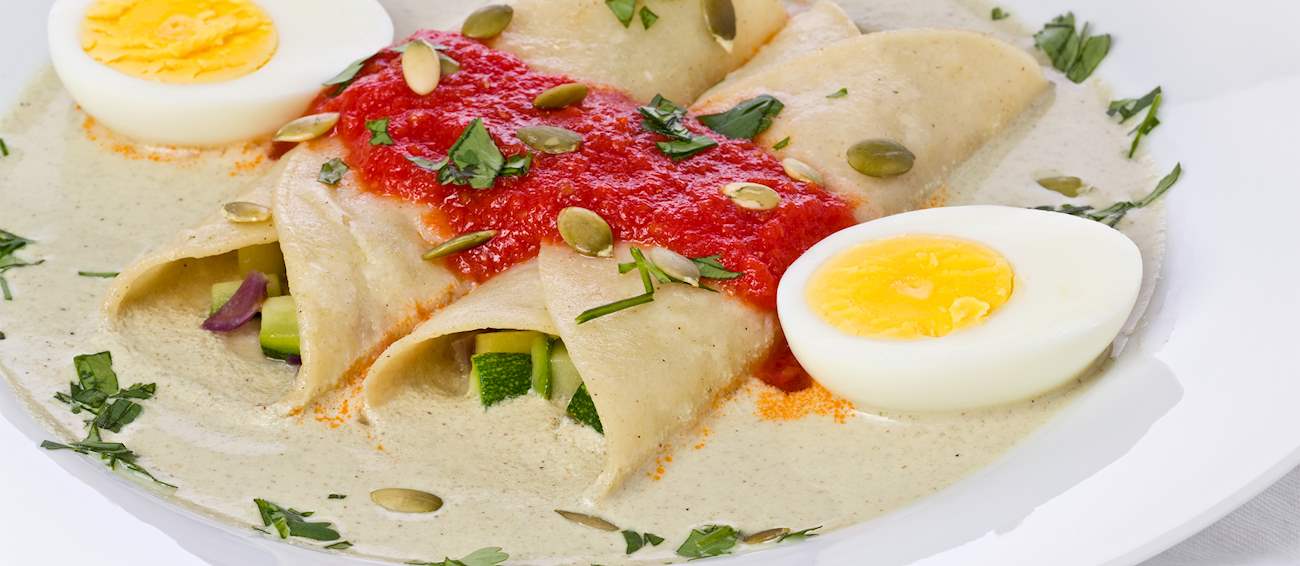Huevos divorciados is a Mexican dish consisting of two fried eggs, each placed on its separate corn tortilla with a different sauce (one has green salsa, the other one red salsa). The dish is served on one plate and is commonly consumed for breakfast.
It is traditionally accompanied by guacamole, refried beans, or spicy potatoes on the side. Crumbled queso fresco and finely chopped cilantro are always used as garnishes, accentuating the flavors of two salsas.
MAIN INGREDIENTS
Papadzules is a Mexican dish with Mayan origins consisting of egg-filled tortillas drenched in a sauce made with pumpkin seeds and epazote. The dish is usually consumed for breakfast on the streets of Yucatan, although it is also found in numerous restaurants and cantinas in the region.
The tortillas are often additionally topped with hot chilis and pickled onions in order to add more flavor to the dish.
MOST ICONIC Papadzules
View moreHuevos migas is a Mexican egg-based dish originating from the Michoacan region. It is made with a combination of soaked bread or tortilla pieces, stock, tomatoes, onions, garlic, chili peppers, and eggs. Cheese and sausage pieces are often added for extra flavor and texture, but due to the fact that the dish is quite popular during Lent, sausages are omitted at that time.
Once prepared, huevos migas are usually served immediately, ideally with hot tortillas on the side.
Affectionately called the breakfast of champions, huevos rancheros is a traditional breakfast dish from Mexico consisting of tortillas, eggs, beans and, sometimes, a selection of meats, all covered with a tomato-chili sauce or salsa. Originally a hearty meal served to farm employees in rural Mexico, the dish found its way north to San Antonio in the USA, just a few miles from the Mexican border.
From there, numerous variations ensued and huevos rancheros became a staple throughout North America with newly added ingredients such as avocado slices, garlic-chile sauce, and melted cheese. Traditionally, it is accompanied by fresh, crisp lettuce and sour cream.
MAIN INGREDIENTS
Gorditas de huevos is a Mexican dish consisting of masa cakes filled with eggs. The gorditas are made with masa harina, salt, and water. The dough is fried on both sides until golden brown, and it is then topped with scrambled eggs. The eggs can be enriched with garlic or chili peppers, if desired.
When served, gorditas de huevos are often accompanied by hot sauces on the side.
Huevos motuleños is a popular Mexican dish categorized by many as a true representative of comfort food at its best. The dish, named after a Yucatan town, consists of crispy tostadas topped with eggs, plantains, roasted tomatoes, and beans, combining both Mayan and Caribbean flavors in one plate.
It is believed that the dish was invented by a Lebanese restaurant owner named Jorge Siqueff Febels when he invited too many guests in his restaurant. As there were not enough bowls and plates, he served all of the side dishes and accompaniments on top of tostadas and eggs, and huevos motuleños was born (and instantly loved).
MAIN INGREDIENTS
Arroz con huevo is a popular lazy lunch throughout Latin America, consisting of rice that’s topped with a fried egg. This humble dish used to be called comida de pobre (poor people food), but today it is enjoyed by people of all socio-economic classes.
The dish has numerous variations, so in the Caribbean it is commonly accompanied by plantains, while the Spaniards pair it with a savory sofrito. It is recommended to top arroz con huevo with some freshly grated cheese and finely chopped parsley.
Huevos ahogados (lit. drowned eggs) is a simple Mexican dish consisting of eggs that are poached in a sauce made with tomatoes, onions, garlic, and (sometimes) chili peppers. Peas are often added for extra flavor and texture. After the eggs have been ''drowned'' in the sauce, they are usually served with warm tortillas, avocado slices, and refried beans on the side, making for a great breakfast that is also a hangover cure for those in need.
Mixiotes de escamol is a Mexican dish originating from the Hidalgo area. It is made by stuffing maguey leaves with a combination of onions, chili peppers, coriander, epazote, and ant eggs. Once wrapped and tied with a string, these packages are steamed, then served immediately with warm corn tortillas on the side.
TasteAtlas food rankings are based on the ratings of the TasteAtlas audience, with a series of mechanisms that recognize real users and that ignore bot, nationalist or local patriotic ratings, and give additional value to the ratings of users that the system recognizes as knowledgeable. TasteAtlas Rankings should not be seen as the final global conclusion about food. Their purpose is to promote excellent local foods, instill pride in traditional dishes, and arouse curiosity about dishes you haven’t tried.





